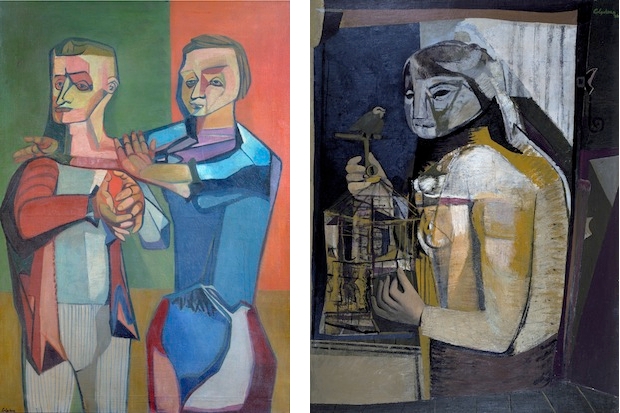In 1933, two new students met on their first day at Glasgow School of Art. From then on they were inseparable. They lived and worked together. They became lovers. They stayed together throughout their lives. They shone at art school, then came to London, where their robust paintings soon became very fashionable. Yet a few years later, just as quickly, their work fell out of favour. They became increasingly impoverished, dependent on friends for bed and board, but they never stopped painting — or loving one another. They were both prolific drinkers. By 1966, they were both dead.
The biography of Robert Colquhoun and Robert MacBryde is so compelling that, even if their work had only been so-so, it’d still be a tale worth telling, a story of fickle fashion and the enduring power of true love. However, as this gripping retrospective proves, their paintings were remarkable — muscular, unsentimental and utterly unique. They came of age alongside Francis Bacon and Lucian Freud, whom they knew and in some respects resembled. Yet as you wander round this exhibition, their first ever two-man show, you realise the only artists they truly resembled were each other.

Ostensibly, the Two Roberts (as their friends all called them) had quite a lot in common. Working-class lads from Ayrshire, they both left school at 15. They were both brilliant draughtsmen, from their earliest days at GSA. They both worked hard, despite the booze. All they ever wanted to do was paint. Their relationship was unpretentious. They never hid their homosexuality, even though it was illegal, yet many of their friends had no idea they were an item. They had a good time, most of the time, but their domestic tastes were simple. The work was what really mattered, and their abiding love for one another. They rarely collaborated, but their early paintings are very similar. Indeed, at first glance it’s often difficult to tell them apart.
Yet, like a married couple in matching clothes, their underlying differences are far more interesting. MacBryde was more practical and sociable. Colquhoun was more prickly and taciturn. Their contrasting personalities are reflected in their art. In the first few rooms of this display, I had trouble working out who did what. Yet gradually, as your eye adjusts, it becomes clear that these stylistic similarities are superficial. Underneath, they’re very different, as distinct as Rubens and Van Dyck. MacBryde favoured still lives, Colquhoun preferred the human form. MacBryde’s paintings are calmer and more colourful. Colquhoun’s are more energetic and intense.

Colquhoun’s star always shone a bit more brightly than MacBryde’s. In their student days he came top, with MacBryde a close second. This pattern was repeated when they moved to London. MacBryde was admired, Colquhoun was fêted. In any other duo, MacBryde would have been the star turn, but as the less acclaimed and more efficient partner, he assumed responsibility for the daily drudgery, a fate that’s befallen a lot of talented wives. In this show Colquhoun’s paintings outnumber MacBryde’s by about two to one. MacBryde was the steady wife, Colquhoun the erratic husband. Colquhoun got more glory, but MacBryde held the fort. His pictures don’t shout so loud, but they’re more measured and sustained.
In most artistic partnerships, this arrangement would be a recipe for fierce resentment. However, to his credit, MacBryde didn’t seem to mind at all. His letters, some included here, were resolutely breezy. Even when their careers collapsed, his correspondence remained upbeat. Since Colquhoun had been more prolific, rejection hit him harder. Because he was more introspective, the pain was more acute. Both men liked a drink, and as their drinking increased (as drinking tends to do) Colquhoun became more withdrawn. MacBryde drank and made merry. Colquhoun drank and drank. In 1962, after working through the night on what should have been his big comeback show, he collapsed and died in MacBryde’s arms. He was 47. MacBryde moved to Ireland and virtually abandoned painting. In 1966, aged 53, he was dancing in the street outside a pub when he was knocked down and killed by a passing car. His last artwork was an illustration for a minor literary magazine.
![The Painters McBryde [sic]and Colquhoun, Ian Fleming](https://www.spectator.co.uk/content/uploads/2015/01/The-Painters-McBryde-sicand-Colquhoun-Ian-Fleming.jpg)
What makes this story such a tragedy is that, beset by alcohol and penury, the pair’s art didn’t deteriorate in the slightest. Their later paintings, painted in poverty and obscurity, are just as powerful and original as their earlier work, sold by trendy galleries to major museums. If they’d lived and prospered, they could have continued for another 30 years.
So why did they fall from grace so suddenly? The usual combination — bad luck and changing taste. Collectors and curators abandoned figuration for abstraction. They were evicted from their studio. One of their most important patrons inconveniently dropped dead. Yet the Two Roberts kept going, treating Kipling’s two imposters, triumph and disaster, just the same. Their greatest achievement, and the great achievement of this super show, is that the pictures they made when they were broke and forgotten in the 1950s are even more arresting than the ones they made in the 1940s, when they were championed by Kenneth Clark, bought by the Tate and MoMA and photographed by Vogue.






Comments